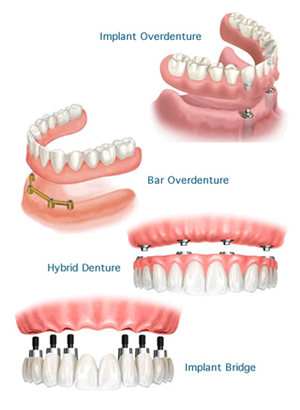Replacing Teeth

An implant
An artificial root onto which crown is attached. A titanium implant is placed in the jawbone by a specialist implant dentist. It is used to support one or more false teeth placed by your local dentist. Ideal option.
No need to trim down adjacent teeth.
Typically lasts a lifetime. Implants are a well-established, tried-and-tested treatment. 95 per cent of modern implants should last for many years with the right care.
You can have any number of teeth replaced with implants from one single tooth to a complete set.
Five or six implants can replace all the teeth in one jaw, as each implant can usually support two teeth.
Placing the implants can be done using a simple local anaesthetic, and sometimes with sedation if you are very nervous. You will not feel any pain at the time, but you may feel some discomfort during the week after the surgery. This is usually due to having stitches, and the normal healing process.
If you have dentures, then these can be worn throughout the healing period.
Have to wait 3-6 months for implant to knit in with bone before crown is attached.
Most artificial teeth attached to implants can only be placed and removed by the dentist.
Loose full dentures can be held in tightly by 2 to 4 implants in the jaw, and you'll be able to take them out for cleaning
Valplast Flexible Denture (Highly Recommended)
Non-metal, thus gum coloured clasps much less noticeable than metal clasps/ frameworks on other dentures.
More comfortable, thinner, smaller. lighter to wear and much stronger than the all-plastic variety.
They are more expensive than the plastic dentures (normally €1,000)
Metal Partial Dentures
(Chrome-Cobalt/Palate-free dentures)
Much stronger, less likely to break, thinner, smaller and lighter to wear than the all-plastic variety.
Although the base is metal, they have gum-coloured plastic and natural-looking teeth fixed to them.
Since they sit on the teeth, as well as being attached to them, they are extremely stable and hold in tighter.
They are more expensive than the plastic dentures (up to a‚¬800).
Acrylic Partial Dentures (plastic dentures)
Breaks easily, thus the acrylic is usually built fairly thick which can take some “getting used to.
Less stable and usually don't hold in as tight as metal dentures.
Intended only as a temporary denture which is placed straight after an extraction. However, bone and gums shrink over time, especially during the first six months after your teeth have been taken out. Thus,your dentures become progressively more lose, thus may need relining (to tighten), adjusting or even replacing. The longer you wait after an extraction, before making the denture the better the fit, but healing may take several months.
If some of the existing natural teeth are extracted for any reason, new false teeth can be added quickly to the denture.
Less expensive (approx. €120 on PRSI).
Bridge
An artificial tooth (crown) is fixed in place by being attached to one or more teeth beside it.
Can last many years if taken care of.
In many people it can take up to 6 months for the gums to heal properly after an extraction. This means that you may need to have a temporary denture (or less commonly a temporary bridge) for a few months before the bridge is fitted.
Traditional Bridge
An artificial tooth (crown) is fixed in place by being attached to one or more crowned teeth beside it. Need to trim down at least one adjacent tooth. Sometimes, the crowned adjacent tooth can become infected. Root canal treatment is very successful and removes the infection over 90% of the time.
Resin Bonded Bridge
This type of bridge involves the artificial tooth being fused to metal bands, and glued to the back of the adjacent teeth with a resin cement.
Commonly used when the teeth missing are in the front of the mouth.
Conservative: involves only minor reshaping of the enamel of the adjacent teeth.
Sometimes less stable than a traditional bridge and can fall out occasionally.
